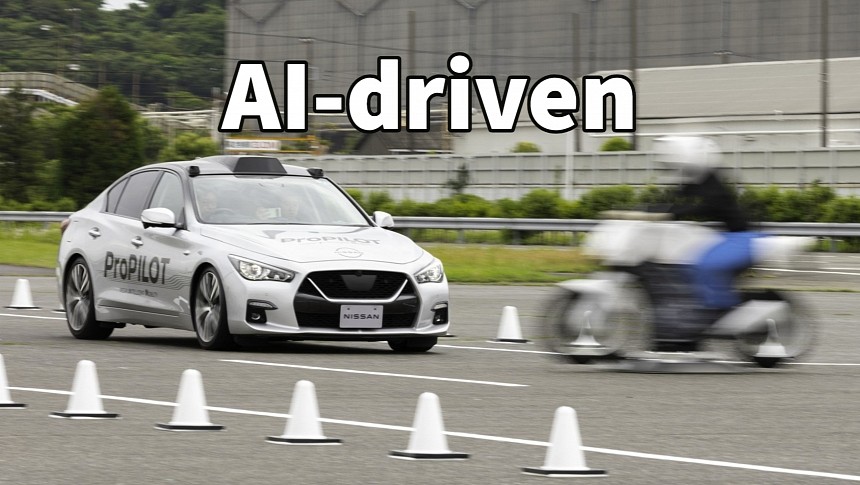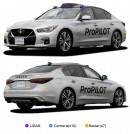Nissan is working on a new generation of its ProPilot driver assist system that leverages LiDAR, camera, and radar to eliminate T-bone crashes and other collisions. Nissan's intersection collision avoidance system is part of a new safety package that should be ready by 2025.
No matter what people think, cars don't kill people, drivers do. Almost all car crashes happening worldwide are caused by humans, either by being distracted, incapacitated or overconfident in their driving abilities. That's why driver-assistance systems promise to help decrease the number or at least the severity of car crashes. Some even believe that eliminating humans from behind the steering wheel will offer a permanent solution.
All carmakers employ some degree of driver assistance, starting with simpler systems such as lane-centering technology, blind-spot assist, adaptive cruise control, or autonomous emergency braking. Some have become mandatory in certain markets, and more are required every year to score the highest safety ratings. Of course, the most expensive systems are reserved for performance or luxury models, although technology does tend to become more affordable in time.
Nissan is working on an advanced driver-assist package that can understand a car's surroundings and help drivers make decisions that can save their lives. The new technology is still in development, but Nissan thinks it could be ready by the end of 2025. It is still named ProPilot, just like the existing driver-assist package in many Nissan vehicles. Still, this one is special because it acts similarly to humans, hopefully without their costly mistakes.
Nissan's next-generation ProPilot system uses what the carmaker names "ground-truth perception" to map the surroundings. It's similar to Tesla's occupancy network but uses a broader sensor suite instead of just cameras. Nissan is a LiDAR evangelist, so the new system uses Luminar sensors together with radar and cameras to enable instantaneous object recognition. These three types of sensors complement each other for the best results.
The technology can detect the shape and distance of objects, as well as the structure of the area surrounding the vehicle, in real time, with a high degree of accuracy. Nissan claims the cars can analyze this information, draw conclusions, and automatically initiate collision-avoidance operations. Although it functions similarly to Tesla's Autopilot, Nissan's ProPilot is not aiming to drive autonomously but only to support drivers' decisions and, hopefully, correct their mistakes.
Nissan demonstrated how its system could help avoid accidents in the complex environments of intersections. The system features a new control logic for intersection collision avoidance based on ground-truth perception technology that can detect an object's speed, location, and potential risk of a collision from a lateral direction. It can also instantly respond to a developing situation. For instance, the system can apply full brakes in dangerous circumstances and release them when the potential risk has been avoided. This can help prevent T-bone crashes, which are caused by driver error and often result in loss of life.
All carmakers employ some degree of driver assistance, starting with simpler systems such as lane-centering technology, blind-spot assist, adaptive cruise control, or autonomous emergency braking. Some have become mandatory in certain markets, and more are required every year to score the highest safety ratings. Of course, the most expensive systems are reserved for performance or luxury models, although technology does tend to become more affordable in time.
Nissan is working on an advanced driver-assist package that can understand a car's surroundings and help drivers make decisions that can save their lives. The new technology is still in development, but Nissan thinks it could be ready by the end of 2025. It is still named ProPilot, just like the existing driver-assist package in many Nissan vehicles. Still, this one is special because it acts similarly to humans, hopefully without their costly mistakes.
Nissan's next-generation ProPilot system uses what the carmaker names "ground-truth perception" to map the surroundings. It's similar to Tesla's occupancy network but uses a broader sensor suite instead of just cameras. Nissan is a LiDAR evangelist, so the new system uses Luminar sensors together with radar and cameras to enable instantaneous object recognition. These three types of sensors complement each other for the best results.
The technology can detect the shape and distance of objects, as well as the structure of the area surrounding the vehicle, in real time, with a high degree of accuracy. Nissan claims the cars can analyze this information, draw conclusions, and automatically initiate collision-avoidance operations. Although it functions similarly to Tesla's Autopilot, Nissan's ProPilot is not aiming to drive autonomously but only to support drivers' decisions and, hopefully, correct their mistakes.
Nissan demonstrated how its system could help avoid accidents in the complex environments of intersections. The system features a new control logic for intersection collision avoidance based on ground-truth perception technology that can detect an object's speed, location, and potential risk of a collision from a lateral direction. It can also instantly respond to a developing situation. For instance, the system can apply full brakes in dangerous circumstances and release them when the potential risk has been avoided. This can help prevent T-bone crashes, which are caused by driver error and often result in loss of life.




































